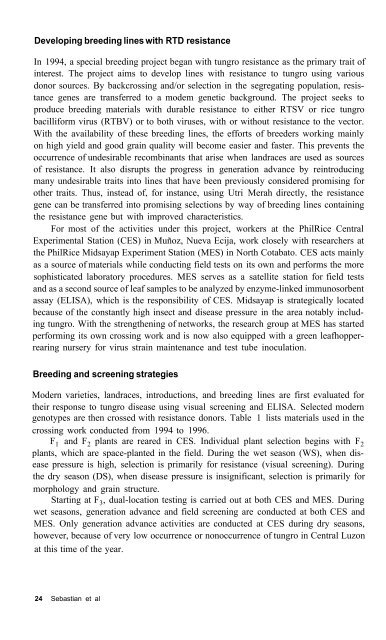Rice tungro disease management - IRRI books - International Rice ...
Rice tungro disease management - IRRI books - International Rice ...
Rice tungro disease management - IRRI books - International Rice ...
Create successful ePaper yourself
Turn your PDF publications into a flip-book with our unique Google optimized e-Paper software.
Developing breeding lines with RTD resistanceIn 1994, a special breeding project began with <strong>tungro</strong> resistance as the primary trait ofinterest. The project aims to develop lines with resistance to <strong>tungro</strong> using variousdonor sources. By backcrossing and/or selection in the segregating population, resistancegenes are transferred to a modem genetic background. The project seeks toproduce breeding materials with durable resistance to either RTSV or rice <strong>tungro</strong>bacilliform virus (RTBV) or to both viruses, with or without resistance to the vector.With the availability of these breeding lines, the efforts of breeders working mainlyon high yield and good grain quality will become easier and faster. This prevents theoccurrence of undesirable recombinants that arise when landraces are used as sourcesof resistance. It also disrupts the progress in generation advance by reintroducingmany undesirable traits into lines that have been previously considered promising forother traits. Thus, instead of, for instance, using Utri Merah directly, the resistancegene can be transferred into promising selections by way of breeding lines containingthe resistance gene but with improved characteristics.For most of the activities under this project, workers at the Phil<strong>Rice</strong> CentralExperimental Station (CES) in Muñoz, Nueva Ecija, work closely with researchers atthe Phil<strong>Rice</strong> Midsayap Experiment Station (MES) in North Cotabato. CES acts mainlyas a source of materials while conducting field tests on its own and performs the moresophisticated laboratory procedures. MES serves as a satellite station for field testsand as a second source of leaf samples to be analyzed by enzyme-linked immunosorbentassay (ELISA), which is the responsibility of CES. Midsayap is strategically locatedbecause of the constantly high insect and <strong>disease</strong> pressure in the area notably including<strong>tungro</strong>. With the strengthening of networks, the research group at MES has startedperforming its own crossing work and is now also equipped with a green leafhopperrearingnursery for virus strain maintenance and test tube inoculation.Breeding and screening strategiesModern varieties, landraces, introductions, and breeding lines are first evaluated fortheir response to <strong>tungro</strong> <strong>disease</strong> using visual screening and ELISA. Selected moderngenotypes are then crossed with resistance donors. Table 1 lists materials used in thecrossing work conducted from 1994 to 1996.F 1 and F 2 plants are reared in CES. Individual plant selection begins with F 2plants, which are space-planted in the field. During the wet season (WS), when <strong>disease</strong>pressure is high, selection is primarily for resistance (visual screening). Duringthe dry season (DS), when <strong>disease</strong> pressure is insignificant, selection is primarily formorphology and grain structure.Starting at F 3 , dual-location testing is carried out at both CES and MES. Duringwet seasons, generation advance and field screening are conducted at both CES andMES. Only generation advance activities are conducted at CES during dry seasons,however, because of very low occurrence or nonoccurrence of <strong>tungro</strong> in Central Luzonat this time of the year.24 Sebastian et al
















